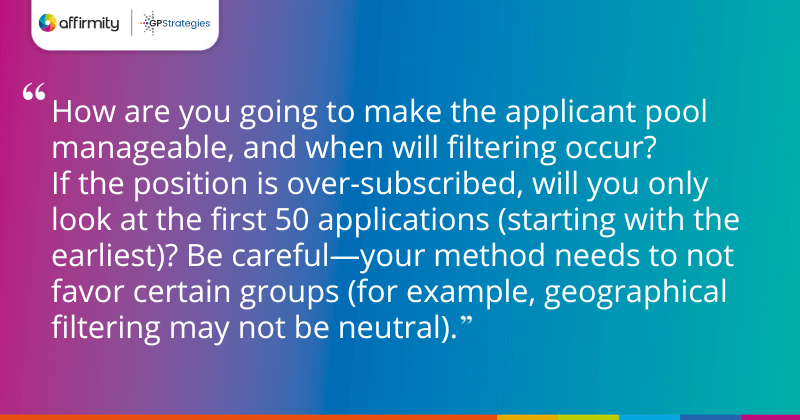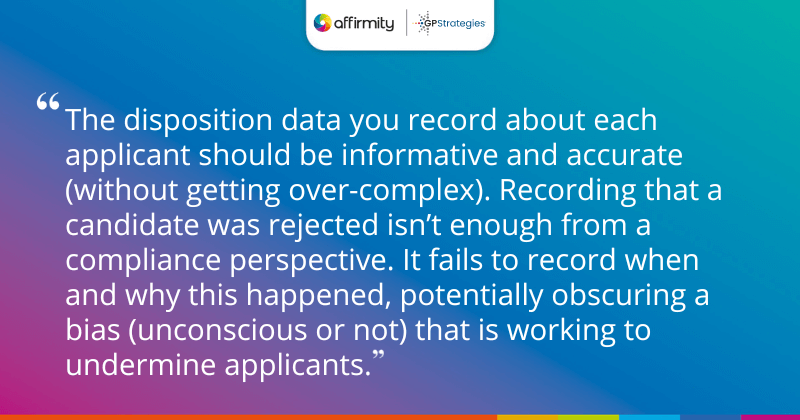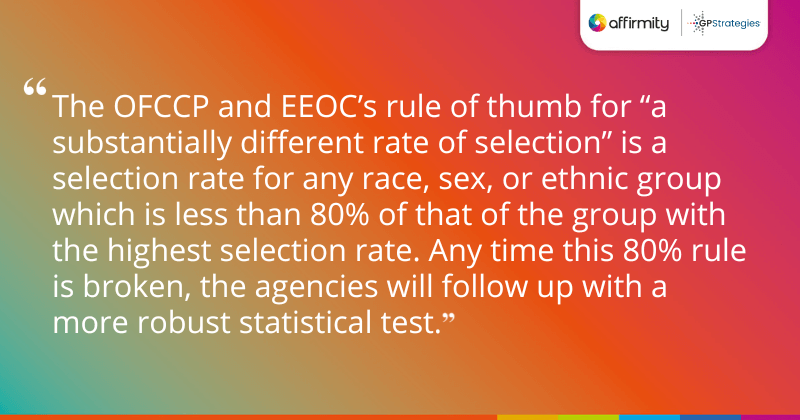The data you collect while complying with hiring law is an important springboard to building an innovative DE&I initiative. In this extract from our guide, ‘Getting Started With Compliance and DE&I: Everything Talent Acquisition Professionals Need to Know’, learn how refining your data-collection methodology will help streamline your overall process.
One of the challenges of working with candidate data in the modern talent process is that you may receive a large number of queries, and these have to be separated from the actual applications in your data. This requires that you clearly define (and stick to!) rules for your applicant pool from the outset. Failure to do so can make it very difficult to defend rejections in the event of a complaint.

1) Key Rules for Your Applicant Pool
These rules should cover:
- Method of acceptance: Will you only accept applications via email, job boards, paper applications, or your organization’s online application system?
- Required documentation: Should applicants provide a resume and/or cover letter?
- Timeframe: Will applications need to be made before a deadline?
- Scope of application: Can applicants apply to multiple positions with a single application or declaration of interest, or should they apply individually to specific positions (a single position at a time approach is generally easier to deal with).
- Data management techniques: How are you going to make the applicant pool manageable, and when will filtering occur?
- For example, if the position is over-subscribed, will you only look at the first 50 applications (starting with the earliest)? Be careful—your method needs to not favor certain groups (for example, geographical filtering may not be neutral).
- Regarding filtering, it’s important to define whether it occurs before or after you check whether applicants meet your basic qualifications.
- Basic qualifications: Define a process for determining the basic qualifications that are required for any given role. This needs to be sufficiently robust so that you avoid having basic qualifications that discriminate unnecessarily.
Consistency needs to underpin these rules: if you apply them in some cases and not in others, you’ll have a hard time defending them.
2) How the OFCCP Defines Applicants
Though employers are able to define and work to a definition of who qualifies as an applicant, these definitions have to take into account OFCCP and EEOC definitions in the US (and equivalents outside).
The OFCCP defines an internet applicant as someone who satisfies the following four criteria:
- “The individual submits an expression of interest in employment through the Internet or related electronic data technologies.”
- “The contractor considers the individual for employment in a particular position.”
- “The individual’s expression of interest indicates the individual possesses the basic qualifications for the position.”
- “The individual at no point in the contractor’s selection process prior to receiving an offer of employment from the contractor, removes himself or herself from further consideration or otherwise indicates that he or she is no longer interested in the position.”
Some of the italicized terms above leave some room for interpretation. For example, a candidate can arguably be considered to have “removed himself or herself from further consideration” by ignoring communication, not showing up to interviews, or some other passive means.
The equivalent EEOC definition can be found here.

ALSO ON THE BLOG | ‘3 Ways to Use Inclusion to Create a Better, More Diverse Work Environment’
3) How to Get Disposition Data Right
The disposition data you record about each applicant should be informative and accurate (without getting too over-complex). Recording that a candidate was rejected isn’t enough from a compliance perspective. Primarily, it fails to record when and why this happened, potentially obscuring some bias (unconscious or not) that is working to undermine applicants and making a hiring analysis impossible.
A good model for covering all bases in disposition terms, without making the process too unwieldy, is to describe three key areas: the step, the status, and the reason. Define a list of valid terms that accurately describes your process (and potentially enforce them via fixed-value dropdowns in your spreadsheet or hiring tool), or use our suggestions below:
Step:
Firstly, indicate the furthest stage in your hiring process that each candidate reached:
- Applied
- Basic qualification screen
- Preferred qualification screen
- Hiring manager review
- Interview
- Second interview
- Offer
- Post-offer checks
- Hired
(Obviously, if your hiring process involves additional steps, you should include them).
Status:
You should then indicate what happened at the final step reached:
- Passed
- Failed or Rejected
- Withdrew
Reason:
Finally, you should record reasons for an applicant’s status in the last step, for example:
- Lacked basic qualifications
- Did not show up for the interview
- Not willing to travel
- Not considered
MORE ON MONITORING | ‘3 Reasons to Monitor Your Affirmative Action Plan (And 3 Ways to Do It Well)’
4) How to Investigate Demographic Differences and Adverse Impact

Establishing the data management processes above makes it easier for your organization to uncover adverse impact. So what is adverse impact? Under the Uniform Guidelines on Employee Selection Procedures (UGESP), adverse impact is defined as a substantially different rate of selection in hiring, promotion or other employment decision which works to the disadvantage of members of a race, sex or ethnic group.
The OFCCP and EEOC’s rule of thumb for “a substantially different rate of selection” is a selection rate for any race, sex, or ethnic group which is less than 80% of the selection rate for the group with the highest selection rate. Any time this 80% rule is broken, the agencies will follow up with a more robust statistical test to determine whether there is a disparity of 2 to 3 standard deviations (a measure of the dispersion of a set of values). We usually advise that 1.96 or higher is really a red flag that needs a closer look.
The following analytical tools can be used to look at diversity yielded by different parts of your program versus expectation, or for other comparative purposes:
- Sourcing analyses: Analyzes whether there are specific hiring sources that are or aren’t performing in terms of yield and quality
- Labor market analyses: Investigates whether the applicant pool is mirroring what is available to you in the qualified labor market.
- Disposition analyses: Requires the full dispositioning of your applicant pool and allows you to investigate groups disproportionately being dispositioned out. For example, you may find that women are falling out of the process when they learn about the hours required. This could lead to you questioning whether you could be more flexible.
- Qualitative content reviews: A manual review of the content of interviews, tests, screens, and other process points to see if content is likely to lead to differential performance or motivation to continue in the hiring process.
- Step analysis: Looks at specific steps in the hiring process
- Combination analysis: Any combination of the above
RECOMMENDED READING | ‘4 Key Components of an Affirmative Action Program’
Getting Started With Compliance and DE&I—Keep Reading!
Talent acquisition professionals have a critical role to play in realizing an organization’s diversity, equity, and inclusion (DE&I) goals. In our full guide, in addition to the clean data principles we’ve looked at above, we also consider:
- The legal obligations you face in US employment law, including the importance of ensuring accessibility across every part of your process
- The processes that will help you ensure that every great applicant is treated with minimal bias, regardless of their background
Download the full guide today.

